engine CHEVROLET ASTRO 1998 2.G Manual Online
[x] Cancel search | Manufacturer: CHEVROLET, Model Year: 1998, Model line: ASTRO, Model: CHEVROLET ASTRO 1998 2.GPages: 414, PDF Size: 21.46 MB
Page 81 of 414
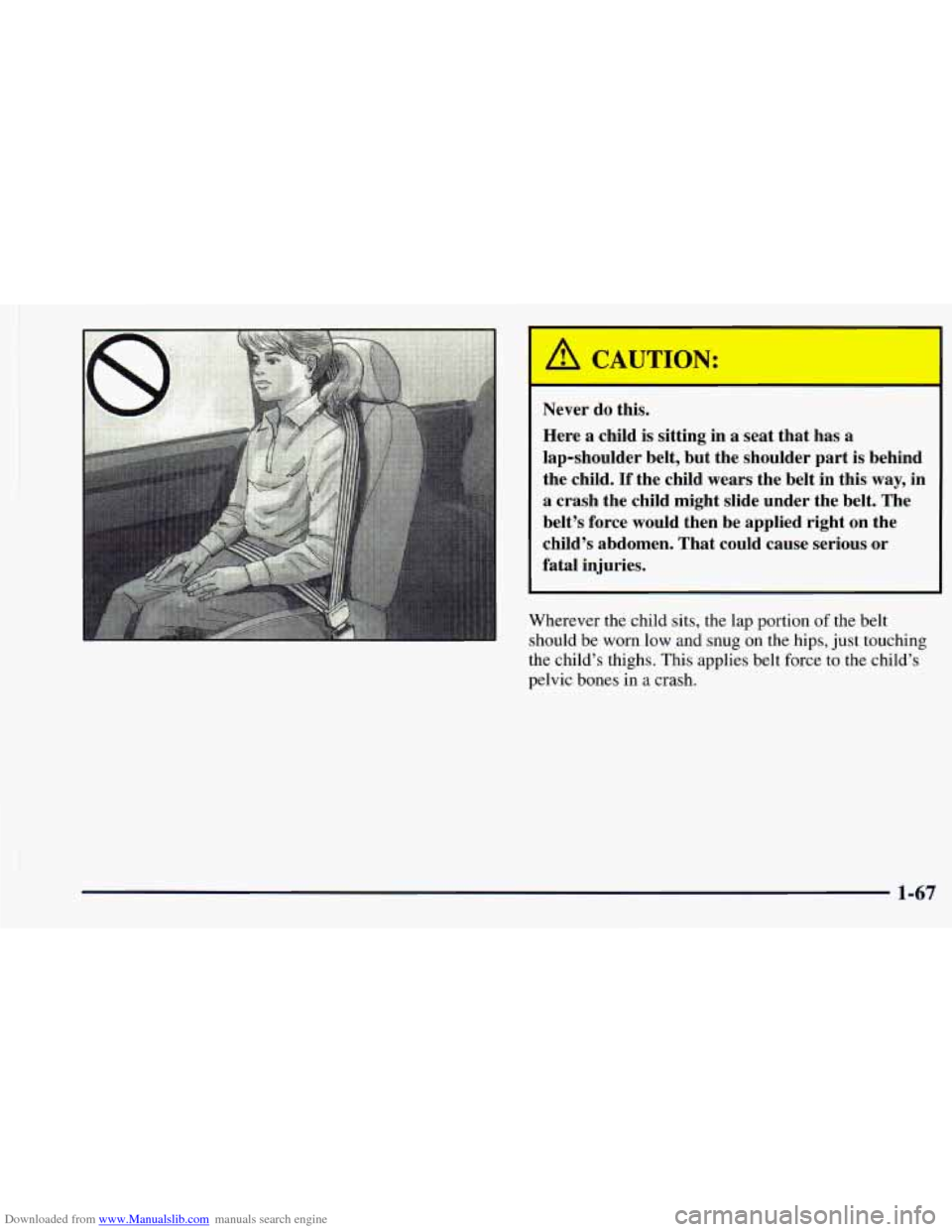
Downloaded from www.Manualslib.com manuals search engine I
I A CAUTION:
Never do this.
Here a child is sitting in a seat that has a
lap-shoulder belt, but the shoulder part is behind
the child.
If the child wears the belt in this way, in
a crash the child might slide under the belt. The
belt’s force would then be applied right on the
child’s abdomen. That could cause serious or
fatal injuries.
Wherever the child sits,
the lap portion of the belt
should be worn low and snug on the hips, just touching
the child’s thighs. This applies belt force
to the child’s
pelvic bones in
a crash.
1-67
Page 82 of 414
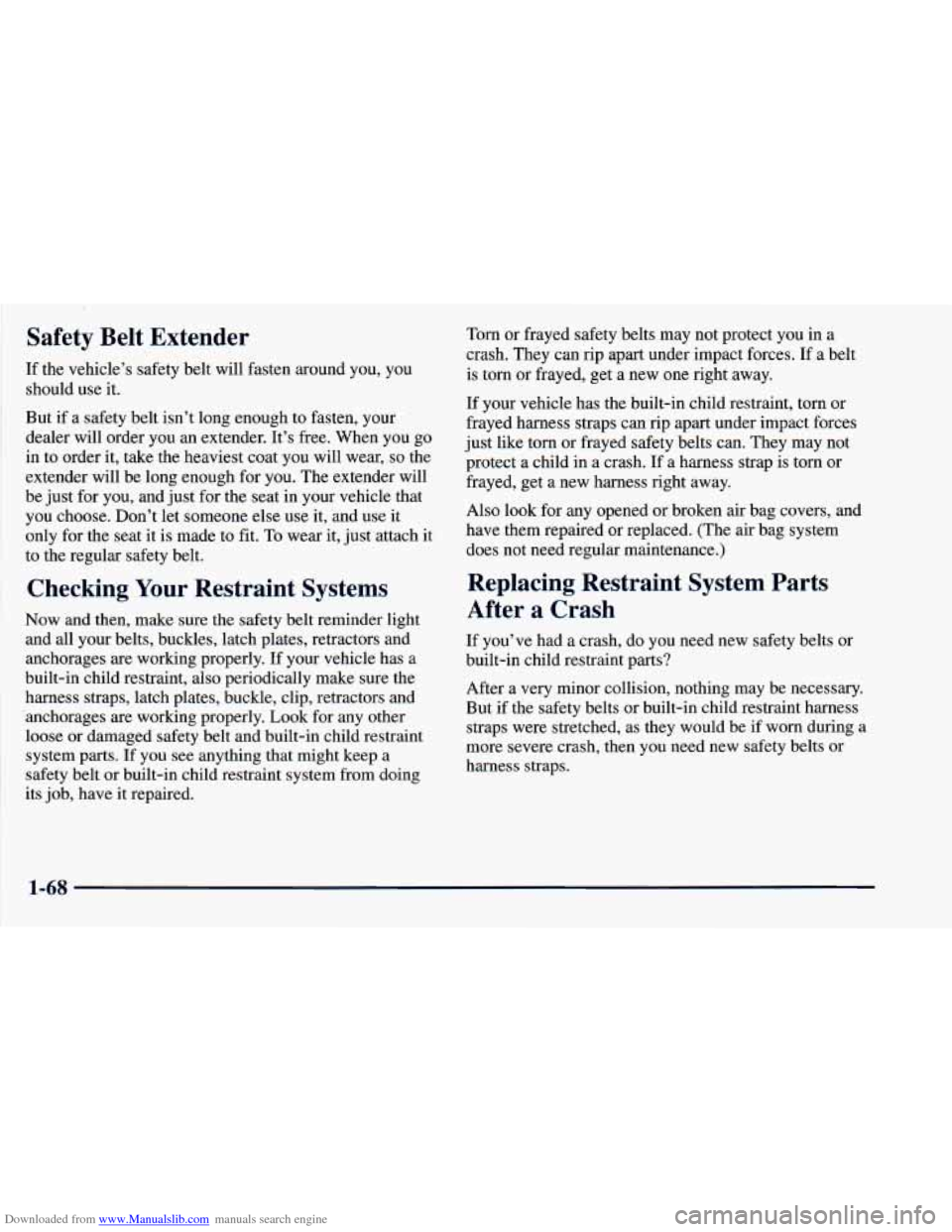
Downloaded from www.Manualslib.com manuals search engine Safety Belt Extender
If the vehicle’s safety belt will fasten around you, you
should use it.
But if a safety belt isn’t long enough to fasten, your
dealer will order
you an extender. It’s free. When you go
in
to order it, take the heaviest coat you will wear, so the
extender will be long enough for you. The extender will
be just for you, and just for the seat in your vehicle that
you choose. Don’t let someone else use it, and use it
only for the seat it is made to fit, To wear it, just attach it
to the regular safety belt.
Checking Your Restraint Systems
Now and then, make sure the safety belt reminder light
and all your belts, buckles, latch plates, retractors and
anchorages are working properly. If your vehicle has
a
built-in child restraint, also periodically make sure the
harness straps, latch plates, buckle, clip, retractors and
anchorages are working properly. Look for any other
loose or damaged safety belt and built-in child restraint
system parts. If you see anything that might keep a
safety belt or built-in child restraint system from doing
its job, have it repaired.
Torn or frayed safety belts may not protect you in a
crash. They can rip apart under impact forces. If a belt
is torn or frayed, get a new one right away.
If your vehicle has the built-in child restraint, torn or
frayed harness straps can rip apart under impact forces
just like torn or frayed safety belts can. They may not
protect
a child in a crash. If a harness strap is torn or
frayed, get
a new harness right away.
Also look for any opened or broken air bag covers, and
have them repaired or replaced. (The air bag system
does not need regular maintenance.)
Replacing Restraint System Parts
After a Crash
If you’ve had a crash, do you need new safety belts or
built-in child restraint parts?
After a very minor collision, nothing may be necessary.
But if the safety belts or built-in child restraint harness
straps were stretched, as they would be if worn during a
more severe crash, then
you need new safety belts or
harness straps.
1-68
Page 83 of 414
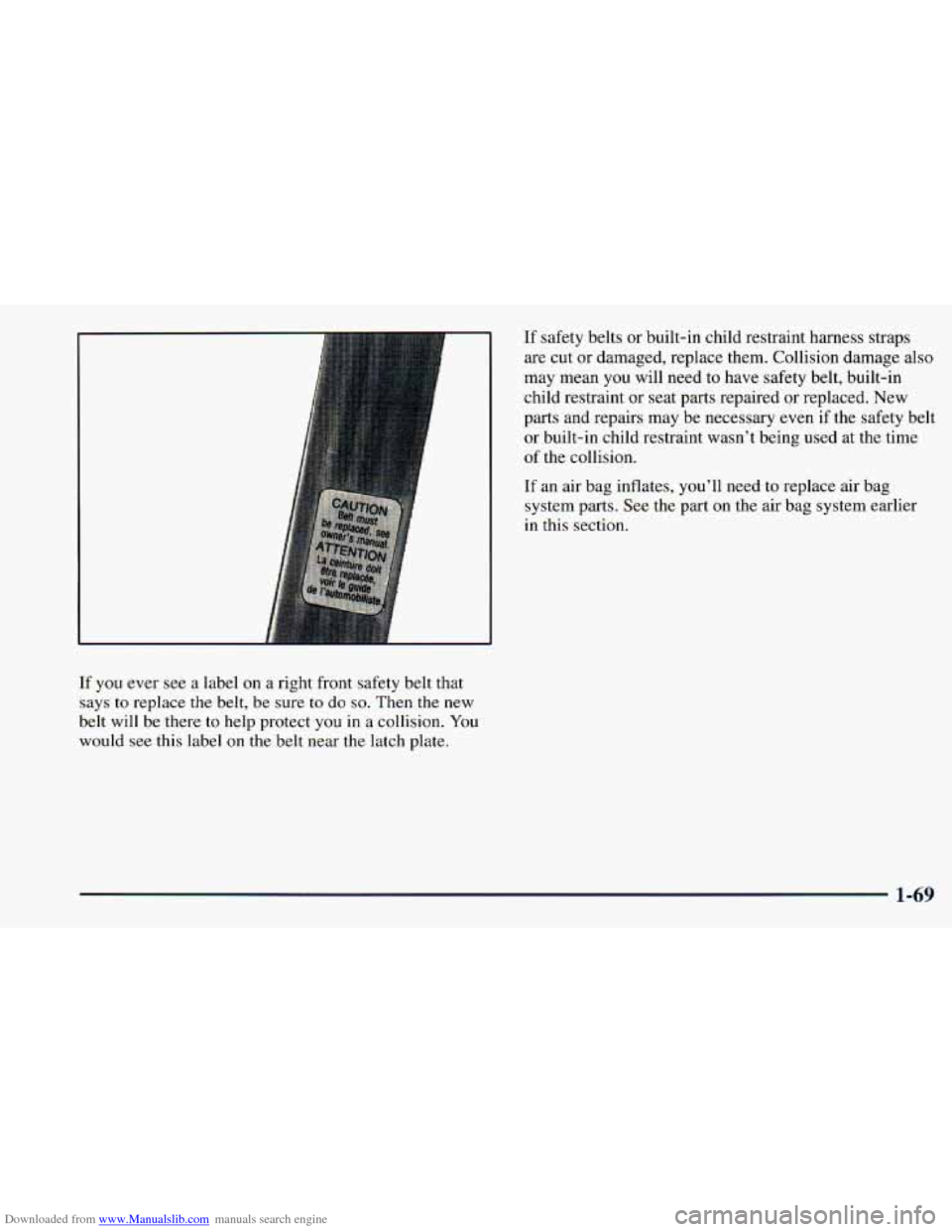
Downloaded from www.Manualslib.com manuals search engine If you ever see a label on a right front safety belt that
says
to replace the belt, be sure to do so. Then the new
belt will be there to help protect you in a collision.
You
would see this label on the belt near the latch plate. If safety
belts or built-in child restraint harness straps
are cut or damaged, replace them. Collision damage also
may mean you will need to have safety belt, built-in
child restraint or seat parts repaired or replaced. New
parts and repairs may be necessary even if the safety belt
or built-in child restraint wasn’t being used at the time
of the collision.
If an air bag inflates, you’ll need to replace air bag
system parts. See the part
on the air bag system earlier
in this section.
1-69
Page 84 of 414
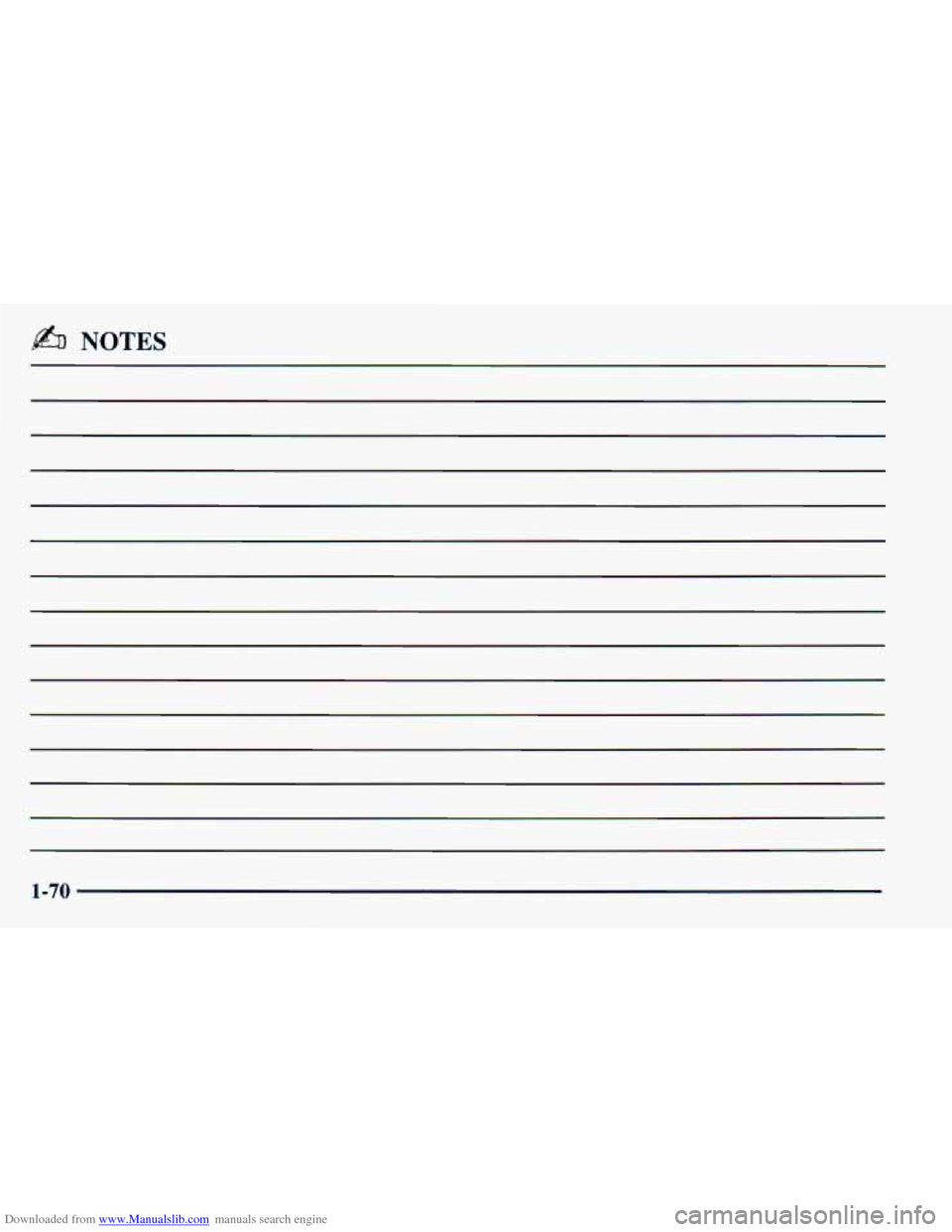
Downloaded from www.Manualslib.com manuals search engine & NOTES
1-70
Page 85 of 414
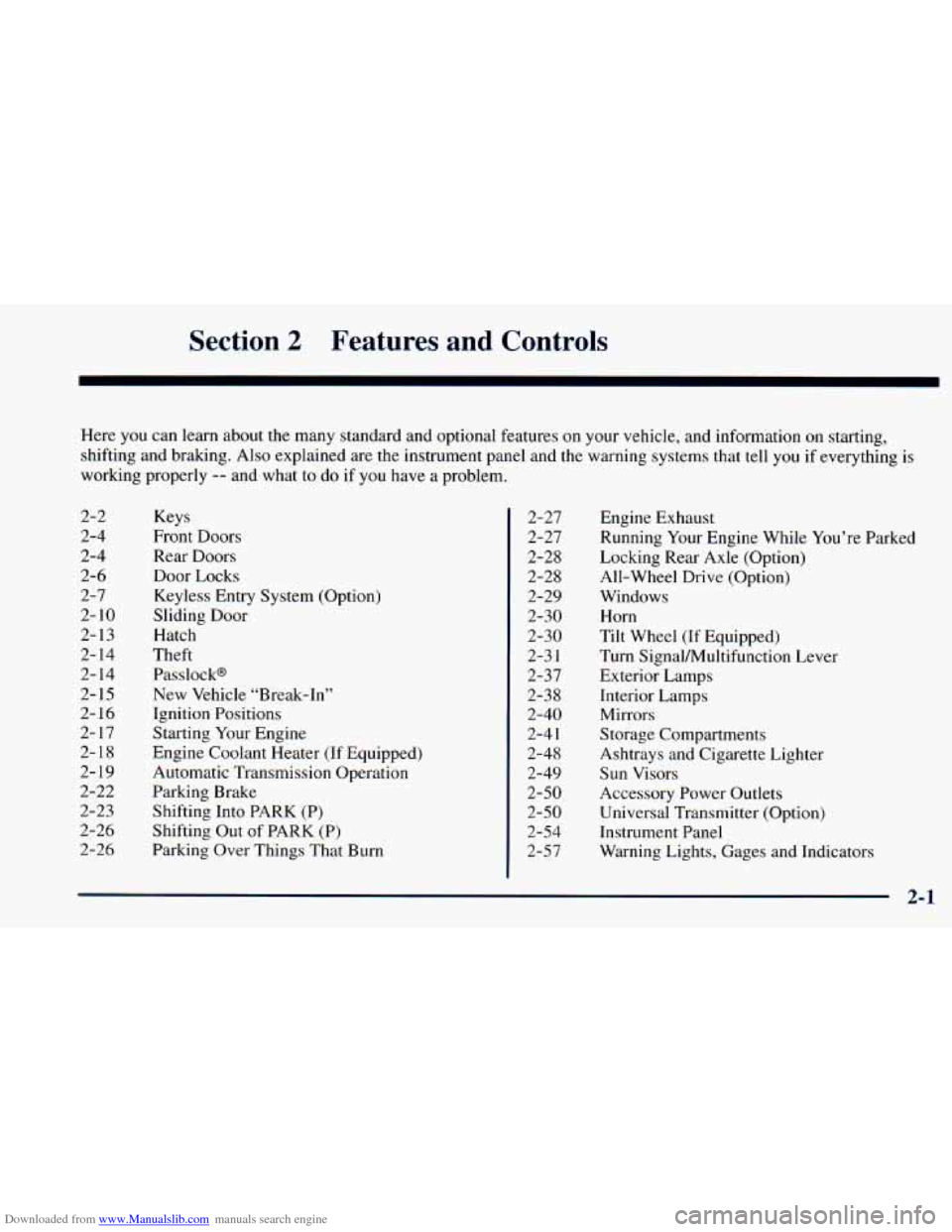
Downloaded from www.Manualslib.com manuals search engine Section 2 Features and Controls
Here you can learn about the many standard and optional features on your vehicle, and information on starting,
shifting and braking. Also explained are the instrument panel and the warning systems that
tell you if everything is
working properly
-- and what to do if you have a problem.
2-2 2-4
2-4
2-6
2-7
2-
10
2-13
2- 14
2- 14
2- 15
2- 16
2- 17
2- 18
2-
19
2-22
2-23
2-26
2-26 Keys
Front Doors
Rear Doors
Door Locks Keyless Entry System (Option)
Sliding Door
Hatch
Theft
Passlock@
New Vehicle “Break-In”
Ignition Positions
Starting Your Engine
Engine Coolant Heater
(If Equipped)
Automatic Transmission Operation
Parking Brake Shifting Into PARK (P)
Shifting Out of PARK (P)
Parking Over Things That Burn 2-27
2-
27
2-28
2-28
2-29
2-30 2-30
2-3
1
2-37
2-38
2-40
2-4
1
2-48
2-49
2-50
2-50 2-54
2-57 Engine Exhaust
Running
Your Engine While You’re Parked
Locking Rear Axle (Option)
All-Wheel Drive (Option)
Windows
Horn
Tilt Wheel (If Equipped)
Turn SignalhAultifunction Lever
Exterior Lamps
Interior Lamps
Mirrors
Storage Compartments
Ashtrays and Cigarette Lighter
Sun Visors
Accessory Power Outlets
Universal Transmitter (Option)
Instrument Panel
Warning Lights, Gages and Indicators
Page 86 of 414
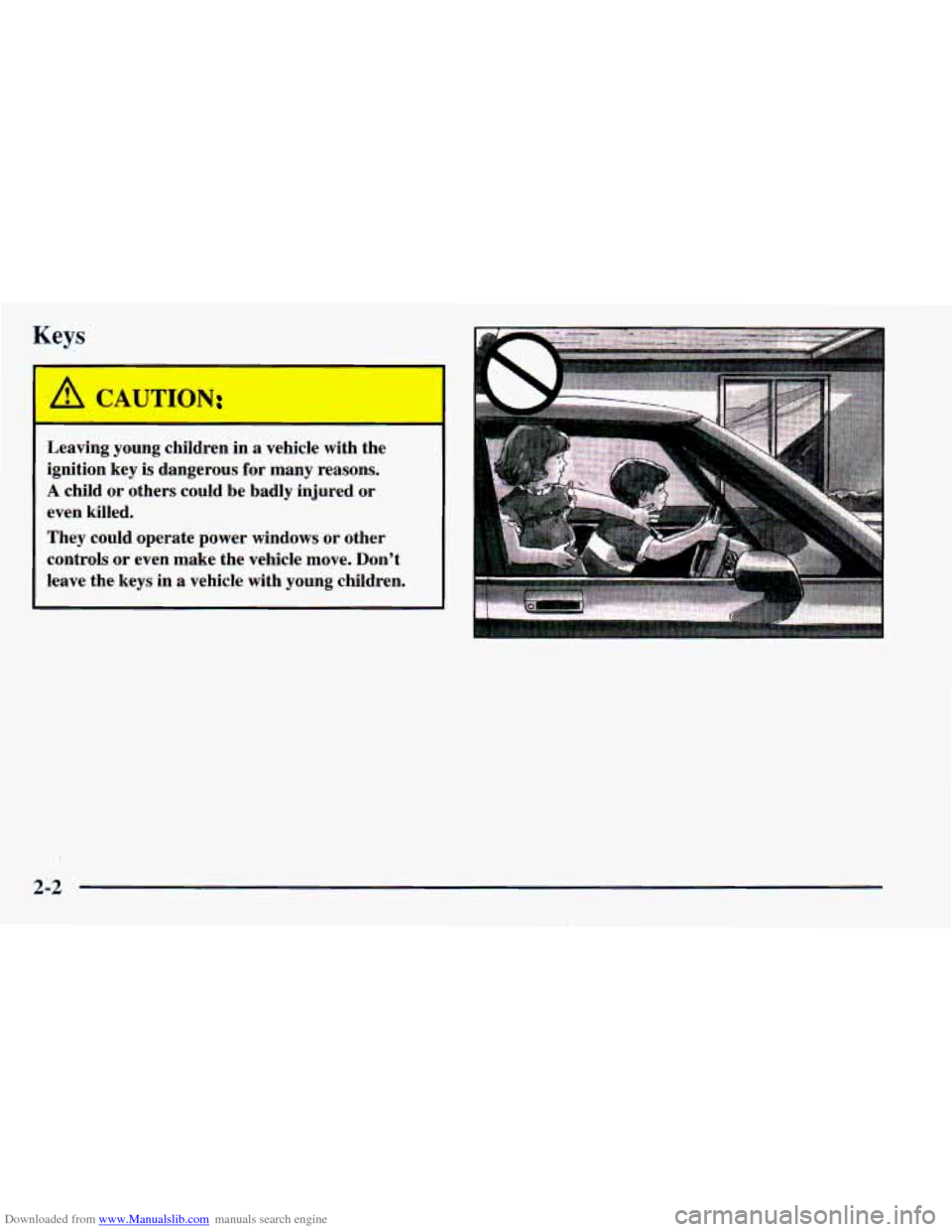
Downloaded from www.Manualslib.com manuals search engine Keys
I
A CAUTION
Leaving young children in a vehicle with the
ignition key
is dangerous for many reasons.
A child or others could be badly injured or
even killed.
They could operate power windows or other
controls or even make the vehicle move. Don't
leave the keys in a vehicle with young children.
2-2
Page 87 of 414
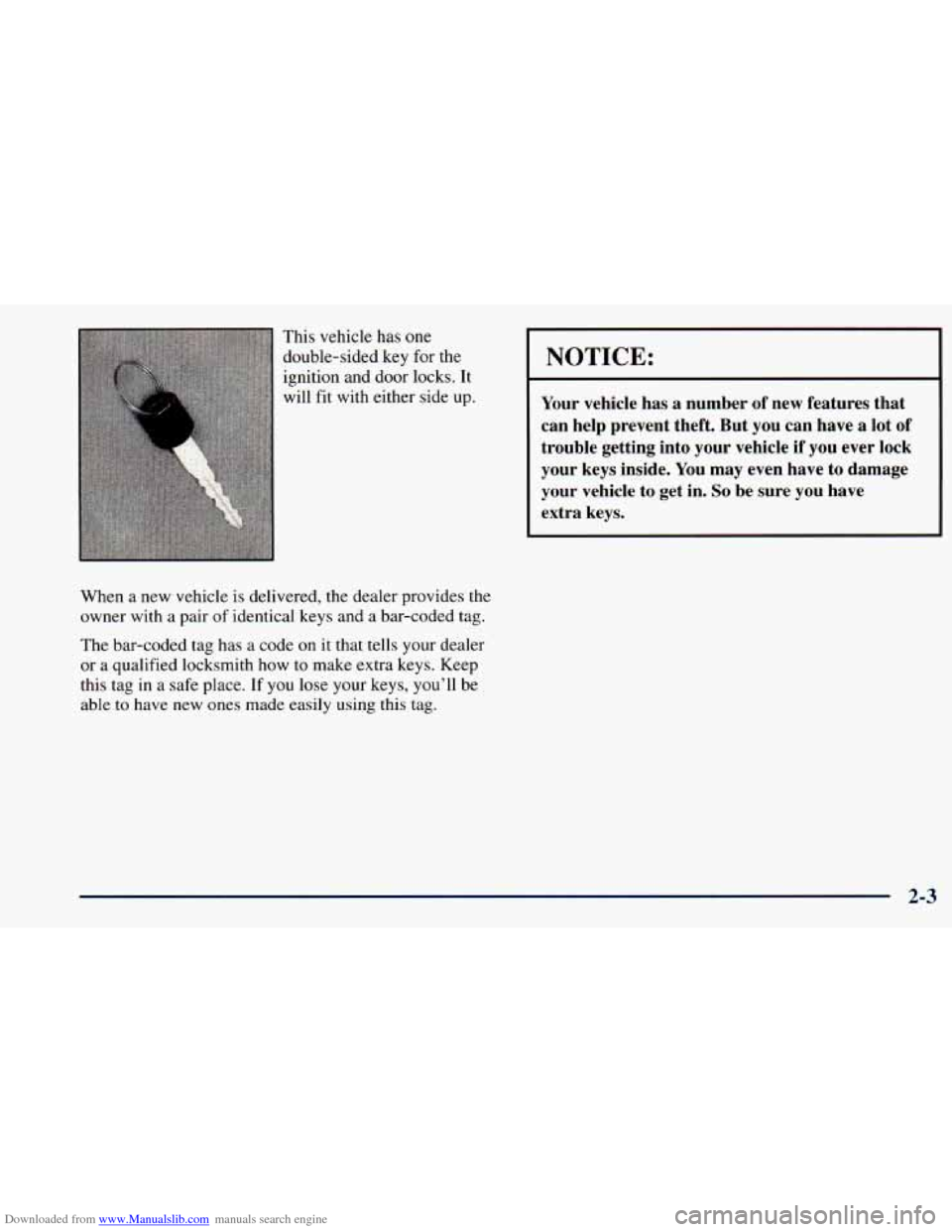
Downloaded from www.Manualslib.com manuals search engine This vehicle has one
double-sided key
for the
ignition and door locks. It
will fit with either side up.
When a new vehicle is delivered, the dealer provides the
owner with a pair
of identical keys and a bar-coded tag.
The bar-coded tag has a code on it that tells your dealer
or
a qualified locksmith how to make extra keys. Keep
this tag in a safe place.
If you lose your keys, you’ll be
able
to have new ones made easily using this tag.
NOTICE:
Your vehicle has a number of new features that
can help prevent theft. But you can have a lot of
trouble getting into your vehicle if you ever lock
your keys inside. You may even have to damage
your vehicle to get in.
So be sure you have
extra keys.
2-3
Page 88 of 414
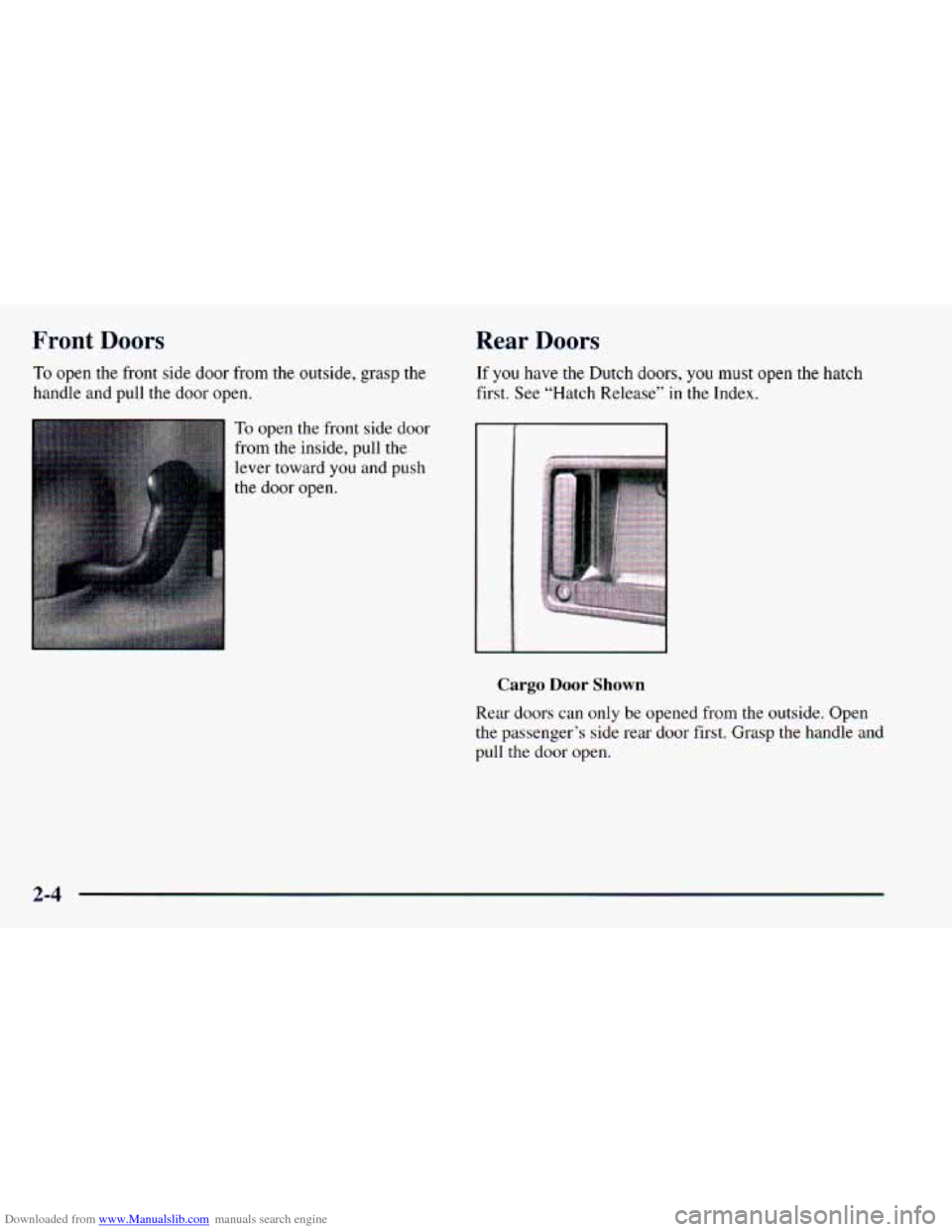
Downloaded from www.Manualslib.com manuals search engine Front Doors
To open the front side door from the outside, grasp the
handle and pull the door open.
Rear Doors
If you have the Dutch doors, you must open the hatch
first. See “Hatch
Release” in the Index.
To open the front side door
from the inside, pull the
lever toward
you and push
the door open.
Cargo Door Shown
Rear doors can only be opened from the outside. Open
the passenger’s side rear door first. Grasp the handle and
pull the door open.
2-4
Page 89 of 414
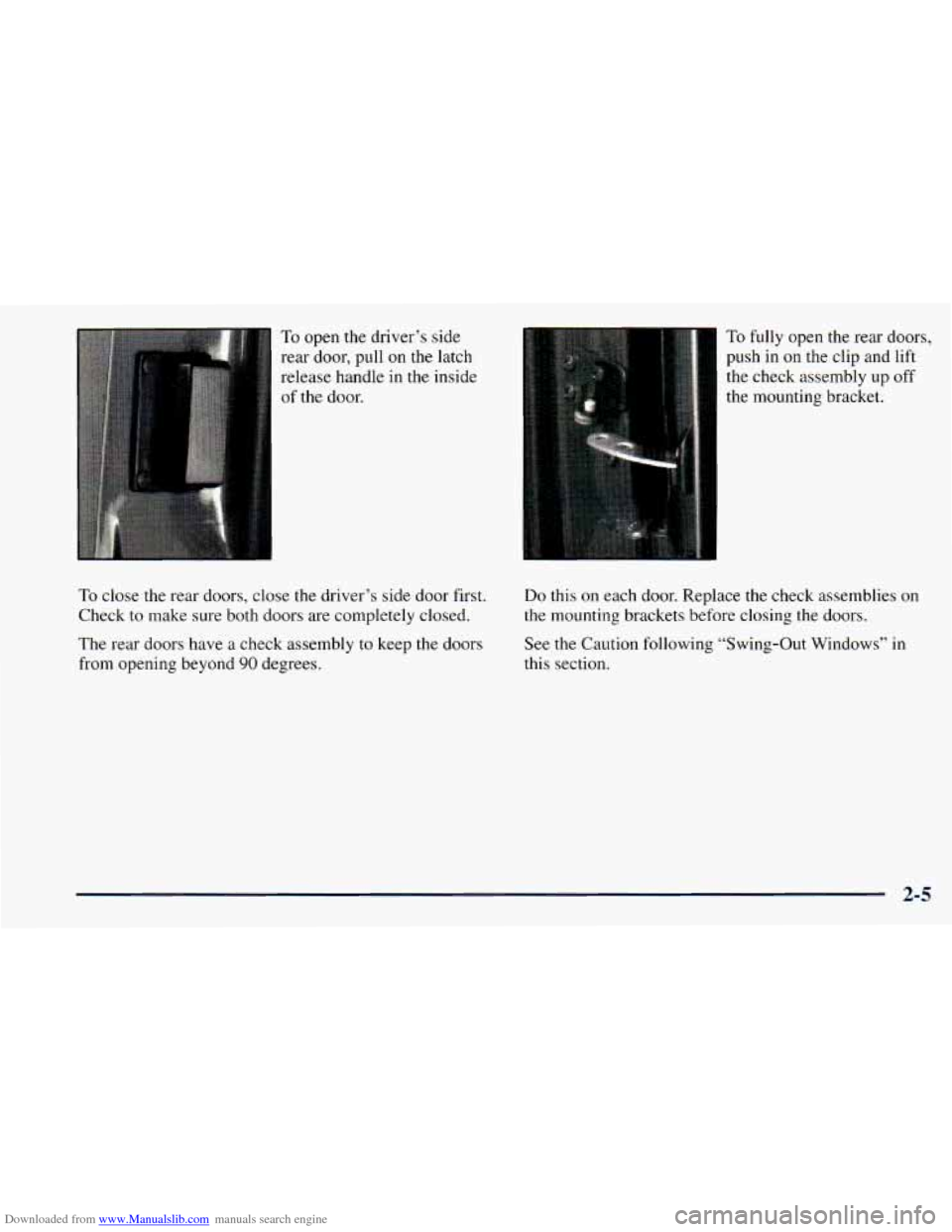
Downloaded from www.Manualslib.com manuals search engine To open the driver’s side
rear door, pull on the latch
release handle in the inside
of the door.
I
To fully open the rear doors,
push in on the clip and lift
To close the rear doors, close the driver’s side door first.
Check to make sure both doors are completely closed.
The rear doors have a check assembly to keep the doors
from opening beyond 90 degrees.
Do this on each door. Replace the check assemblies on
the mounting brackets before closing the doors.
See the Caution following “Swing-Out Windows” in
this section.
2-5
Page 90 of 414
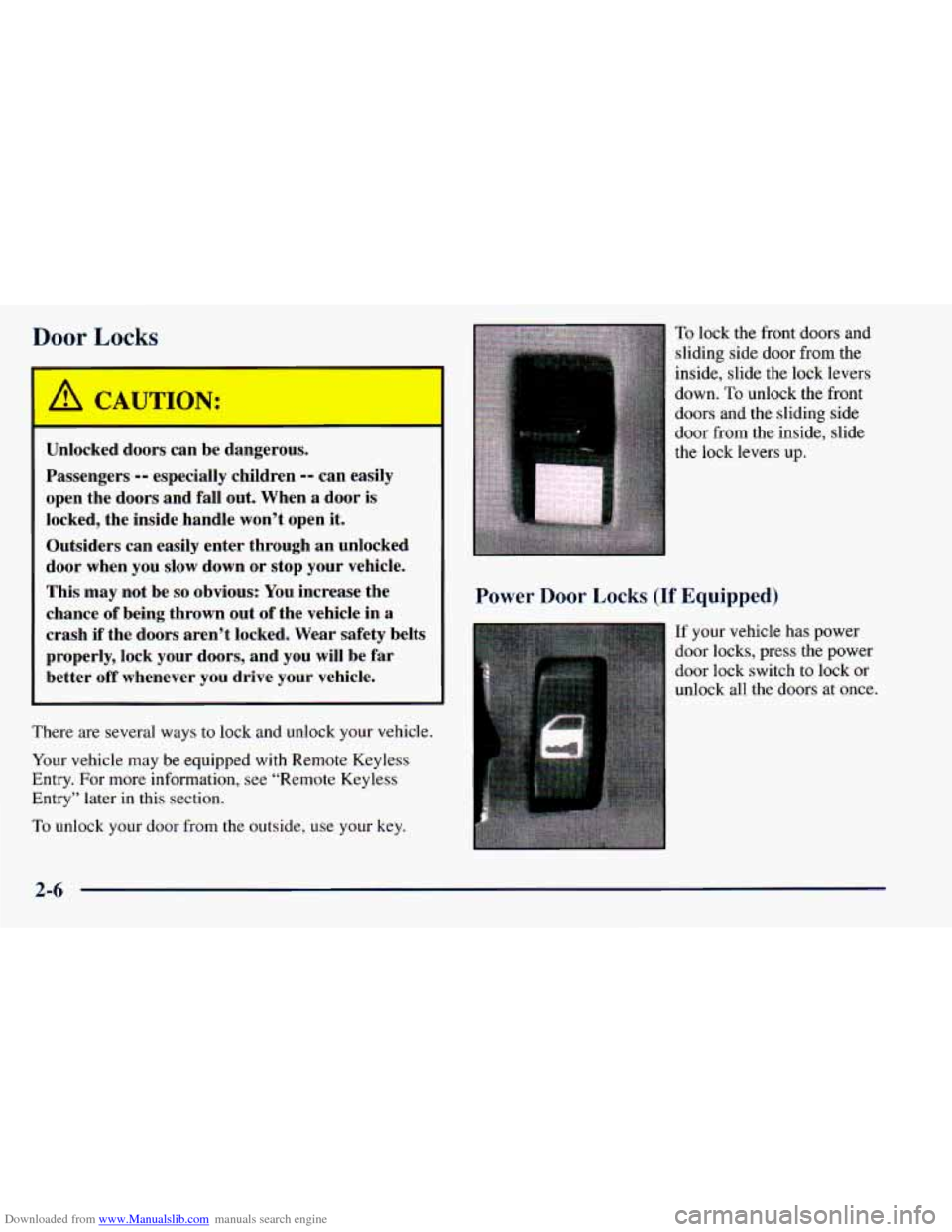
Downloaded from www.Manualslib.com manuals search engine Door Locks
I
I
Unlocked doors can be dangerous.
Passengers
-- especially children -- can easily
open the doors and fall out. When a door is
locked, the inside handle won’t open it.
Outsiders can easily enter through an unlocked
door when you slow down or stop your vehicle.
This may not be so obvious: You increase the
chance of being thrown out
of the vehicle in a
crash if the doors aren’t locked. Wear safety belts
properly, lock your doors, and you will be far
better
off whenever you drive your vehicle.
There are several ways to lock and unlock your vehicle.
Your vehicle
may be equipped with Remote Keyless
Entry. For more information, see “Remote Keyless
Entry” later in this section.
To unlock your door from the outside, use your key.
To lock the front doors and
sliding side door from the
inside, slide the lock levers
down. To unlock the front
doors and the sliding side
door from the inside, slide
the lock levers up.
Power Door Locks (If Equipped)
If your vehicle has power
door locks, press the power
door lock switch to lock
or
unlock all the doors at once.
2-6